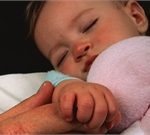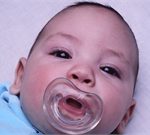Rash
It is almost impossible for a doctor to know for certain what a rash is without seeing it. Most rashes are not worrisome and require no treatment. This page is to help you recognize common childhood rashes, to decide if/when you need to call your doctor, to figure out if/when the rash is contagious, and of course to see if there is anything you can do for the rash. If your child is happy and playful the likelihood of the rash being serious or dangerous is very low.
The rashes that require immediate medical attention are described at the end of this information page. If your child has a rash that is flat and is PURPLISH, or if the rash is FLAT, PINPOINT and a deep dark red please skip to the bottom of the page.
Rash Types
Heat Rash
Fine pink bumps most commonly on areas of contact, pressure or friction. There are usually no other symptoms – a happy child with no fever. Airing out and cooling the area helps to calm the rash. No treatment is necessary.
Allergic Rash
Acute: Allergic reaction/Hives – a reaction usually to food or to an insect sting. The rash tends to be pink and raised, itchy, it can be hive-like (a larger, dime to quarter sized welt) and might appear in one area or all over the body. The rash can come and go over 3-7 days, even after the initial trigger is gone. Treat the rash and itch with diphenhydramine (ex: Benadryl) every six hours (see medication dosing page). Cooling the skin with water or ice can be soothing and calm the itch. If your child has any difficulty breathing or swelling of his/her face or lips see a doctor immediately.
Chronic: Atopic dermatitis and Eczema. This is a dry and irritated rash. It is usually itchy and can show up as bumps or patches. The patches can be circular or irregular. Some common areas to find this rash are behind the ears, behind the knees, and in the folds of the elbow. But it can show up anywhere on the body and might come and go. When the patches are only dry, not red, use moisturizing agents (see below) to treat it. When the patches are red and angry you can use 0.5% – 1% hyrdrocortisone three times a day for 5 days. You should not use hydrocortisone on the face or diaper area and you should not use for longer than 7 days without discussing first with your doctor. Call your pediatrician during regular office hours if the rash is not showing any improvement within 3 days, or if you notice it getting worse.
Poison Oak, Ivy, and Sumac. The rash from coming into contact with the oil on the leaves of these plants is an allergic rash. The typical rash is intensely itchy and consists of red patches and tiny to small blisters. The blisters can break and the area can become weepy and have some crusting. Until the oil is washed off of the skin it can be spread to other areas on your child’s body. It can take 2-3 washings with soap and water to completely remove the oil. Tecnu soap is very effective so use it if you have it available. Wear gloves to remove all affected clothing and shoes to prevent spread of the oil, and wash the clothing and shoes in hot water. Wash your child’s skin with mild soap and water, rinse, and repeat 2-3 times. Apply hydrocortisone cream three times a day for 3-5 days. To relieve the itch use cool compresses, calamine lotion, aloe gel and, if needed you can give your child a dose of diphenhydramine/benadryl (see medication dosing page). There are some ways of alleviating the itch which are initially painful and burn, so only consider these in a child who is old enough to want and agree to these: put rubbing alcohol in a spray bottle and spray onto the affected area 2-3 times a day; hold a hair blow dryer 3-8 inches away from the rash and blow the heat onto the affected area for up to one minute, not longer, repeat 2-3 times as needed to relieve itch.
If the rash covers a large area, is on the face or genitals, or is not improved by the methods listed above, contact your pediatrician. If the rash is affecting your child’s eyes, see a doctor immediately.
Viral Infections
Chicken Pox- Varicella
Children will often have a runny nose and fever for the first 3-5 days
Rash – fluid filled blisters on a red base, and very itchy. The blisters come out slowly at first, so your child might have some new pink bumps, some fluid filled blisters, and some scabbed areas all at the same time. Having many lesions in different stages is typical of Chicken Pox. It might be two weeks before all lesions are scabbed over.
Contagiousness – A child is contagious for 1-2 days before the rash appears and continues to be contagious until every blister is scabbed over. When a child has been exposed to chicken pox it can take 14-21 days before he/she shows the first signs of illness.
Prevention – Chicken Pox/Varicella vaccine. If your child has never been vaccinated and has been exposed to someone with chicken pox vaccinating within 3-5 days of exposure can prevent or reduce the seriousness of the disease.
Complications – Skin infections and Pneumonia. If your child has any lesion that is getting very red, angry, tender, pus-filled or if your child has any difficulty breathing call your doctor.
Roseola
The typical presentation is a child who has had a fairly high fever for a few days, and who is finally feeling better when a rash appears.
Rash – Pink, bumpy or flat (and doesn’t bother your child much).
Contagiousness – Your child is contagious 1-2 days before the illness begins and will be contagious until s/he is fever free for 24 hours. So by the time the rash appears your child is usually no longer contagious.
Hand-Foot-Mouth (Coxsackie Virus)
This is a very typical childhood illness. The rash appears within 1-2 days of onset of fever, and children can have fever for 3-5 days. It is often accompanied by a runny nose, cough and congestion.
Rash – This should be called hand-foot-mouth-butt disease because those are the areas most affected during this illness. Sometimes a child will have a body rash as well. The typical rash has pink bumps that blister and then ulcerate, and is distinctive because it can be found on the palms of the hands and soles of the feet. The most uncomfortable part of this illness is the mouth ulcerations. They can range from only a few to many and make eating and drinking painful. The diaper rash is also uncomfortable so leaving the area open and covering with an ointment (Vaseline) might lessen your child’s discomfort.
Contagiousness – Your child is most contagious during the first week of illness.
Complications – The most common complication is dehydration. Your child’s mouth is very sore and s/he will resist eating and drinking. Your focus should be on fluids – be sure to avoid anything salty or citrus-y. Popsicles are often preferred because they are so cold that they partially numb the ulcerations inside the mouth. You can try to apply Maalox directly to oral ulcerations, followed by orajel (teething ointment) to soothe and numb the mouth lesions. If your child is not taking any fluids and does not urinate at least three times in 24 hours, call your doctor.
Fifth’s Disease/Parvovirus
This is yet another very common childhood illness which often involves fever, runny nose, cough and a rash.
Rash – The rash begins with bright red cheeks, which is how it has earned the common description of ‘slapped cheeks’. Your child might then develop a pink raised rash, or a flat lacy rash all over his/her body.
Contagiousness – Your child is contagious 24 hours before the rash and/or fever begin and is no longer contagious when he/she is fever free for 24 hours.
Complications – If a pregnant woman has never had this illness before and is exposed during the first half of her pregnancy there is a very small risk of a miscarriage. Remember that most of us have had this illness during childhood, so try not to panic if you are in the early stages of pregnancy. You can call your OB/GYN to discuss your exposure with him/her.
Generic Viral Rash
There are so many viruses it would be exhaustive to list them here, and as you can see by the above, most cause the same symptoms. Fever for 3-5 days, +/-runny nose, +/- cough, and a pink bumpy or flat rash all over the body or mostly on the trunk. The rashes are not themselves contagious, so once your child is fever free for 24 hours you can send them to school and resume playdates.
Bacterial Infections
Impetigo
Impetigo is a bacterial infection of the skin typically found around the mouth, usually at the corners and directly above and below the lips, but it can be found anywhere on the body. The typical impetiginous rash is red/pink. It blisters and then develops a yellow or honey colored crusting. It is spread by direct contact, and scratching causes spread. So keep your child’s fingernails short. You should try using a triple antibiotic ointment on it three times a day (polysporin, Neosporin, etc), but if it is not improving within 3 days of treatment call your doctor for a prescription ointment.
Folliculitis/Boils
Folliculitis is an infection of the hair follicle. This can appear as small areas of pus (like pimples) on a red base. You can treat this rash with a topical antibiotic ointment (Neosporin/polysporin). If the area becomes hard, larger over time, very tender, deep, or if it is draining pus, you should call your pediatrician during normal business hours. S/he might want to drain it, send some of the fluid to a laboratory for evaluation, and begin oral antibiotics. If your child has fevers and nausea with boils you should call your doctor immediately.
Cellulitis
Cellulitis is an infection of the skin. It often begins with an insect bite that has been picked, or a mild injury that has not been kept clean. The area surrounding the bite/injury is red, warm, and tender to touch. This area becomes larger over time. Call your pediatrician during regular hours to have your child evaluated if you suspect cellulitis. To prevent an injury or bite from progressing to the point of cellulitis, try to keep your child from picking at his/her skin, wash the affected area with mild soap and water, and put triple antibiotic ointment (Neosporin, polysporin) on the area until it has healed and the skin is no longer broken. If your child has cellulitis with fever, nausea, and/or red streaks extending out from the affected red area you should call/see your doctor immediately.
Fungal Infections
Ringworm (Tinea Corporis and Tinea Capitis)
Ringworn is caused by a fungus and is transmitted by contact with an infected person or animal (dogs and cats, most typically a kitten). The rash usually starts as a single area of raised red bumps in a circular pattern with normal skin in the middle. It can include many lesions and does spread with scratching. The treatment is over-the-counter Lotrimin AF (clotrimazole) or Lamisil (terbinafine) twice a day for several weeks, or until clear. If you cover the area there is no reason to keep your child separated from other children.
If the area affected is on the scalp (Tinea Capitis) it will often lead to hair loss in the affected area. Unfortunately creams tend to be ineffective in treating this type of fungal infection so you will likely need to see your child’s pediatrician if you suspect tinea capitis.
A note: Numular eczema occurs on the body, is circular in shape and is often confused with ringworm. If the center of the lesion is red or scaly it is likely to be eczema, not ringworm, so treat accordingly!
Athlete’s Foot (Tinea Pedis)
This is caused by a fungus and occurs on the feet, usually between the toes. The fungus causing athlete’s foot thrives in a warm, moist environment. It is transmitted by direct contact with an infected person, and by contact with an object that has been contaminated – especially mats and flooring in and around saunas, swimming pools, community showers and locker rooms. Affected areas tend to be red, itchy, dry and can burn or sting. The skin may become cracked and raw. Wearing water shoes in showers and locker rooms, wearing dry socks (changing out of wet/sweaty socks), avoiding plastic shoes, and avoiding tight fitting shoes may all help prevent athlete’s foot from occurring and spreading. To treat athlete’s foot wash and dry the affected area, then use an over-the-counter anti-fungal cream, spray or powder twice a day for two to four weeks. Some over the counter options are Lotrimin AF (clotrimazole), Lamisil (terbinafine), or Tinactin (tolnaftate).
Warts
Warts are raised areas of skin, often with a rough center, usually found on the hands and feet. Their cause is a virus that makes skin cells grow in an unusual way. The problem with warts is that the body does not realize that the virus is present so does nothing to fight it off. All of the treatments are geared towards irritating the skin enough to get the body’s attention, because once that is accomplished the body should take over and kill the virus.
Home Treatments
Duct Tape – Cover the wart with duct tape. Leave the duct tape on for a week (if it is wet/dirty just replace with a clean piece of tape). At the end of the week remove the duct tape and soak the affected area. Use a pumice stone or an emery board to file the area down, then put a clean piece of tape on the area for another week. Repeat this process – it often takes more than 6-8 weeks before you see results.
Salicylic acid – This is available as a liquid or pre-medicated patch at most grocery and drug stores. Soak the wart in warm water for five minutes then pat dry before applying the liquid or patch. Do this twice a day, and file the skin as you notice it softening. As the acid works the area may blister and the wart might lift off. Once again, it can be more than 6-8 weeks before you see results.
Office Treatments
If the wart is not responding to duct tape or salicylic acid, or if it is very painful and interfering with your child’s day to day activities, contact your doctor during normal business hours for treatment by your primary care doctor or by a dermatologist or podiatrist.
Molluscum Contagiousum
This is another type of wart, but appears as crops of skin colored bumps. The bumps often have a slight dimple in their center. They can be smaller, and can be more itchy, numerous and contagious than classic warts. They are also more difficult to treat because of their greater numbers. Treatment is the same as it is for classic warts (see above). Many doctors and families choose not to treat because if left untreated molluscum often resolves in under a year.
Keratosis Pilaris
This rash consists of flesh colored bumps that most commonly appear on the sides of the cheeks, backs of the upper arms, and tops of the thighs. It is essentially normal skin in people who have a history themselves, or a family history, of allergies and eczema. The rash looks a lot like goose bumps, is not contagious, and requires no treatment. If you scratch or pick at the bumps they will become red and a white substance (keratin) might come out. There is no reason to do anything for this rash. It is not itchy and is a variant of normal skin. If you do not pick at the bumps and keep the area well moisturized this lessens its appearance. In some people the bumps resolve with time, in others it lasts a lifetime. Remember – not a cause for concern!
General Rash Treatment
Supportive care:
If it itches, try hydrocortisone cream (unless it is clearly bacterial or fungal), or oral benadryl (see medication dosing page)
If your child has fever, try acetaminophen or ibuprofen (see medication dosing page)
Remember that anything that makes the skin warm (fever, hot water, activity/sweating, sun exposure) will make the rash flare – aggravate redness and itching if they are present.
For a dry rash, atopic dermatitis and eczema:
Moisturizing:
- Bathe (up to 2-3 times a day) in water that is warm, but not hot.
- Use very mild soaps (avoid perfumes/fragrances).
- Pat the skin dry (do not rub).
- Within 2 minutes of drying apply one of the following:
- Oils and ointments (aquaphor, Vaseline)–these have the highest content of oil
- Creams – these contain more moisturizing oils than lotions, less than ointments/oils
- Lotions – these are less greasy but also the least moisturizing
- Moisturize at least two to three times a day.
- Rinse off after swimming, pat dry, and moisturize immediately.
If your child is/has the following you need to call your doctor:
- Rash is present for more than four weeks.
- Difficulty breathing
- Swelling of the face and/or lips
- Signs of bacterial infection (as described above)
- Poison Oak/Ivy/Sumac involving the face or genitals.
- If your child is worrying you, is very uncomfortable or if your gut feeling is that something big is wrong.
Call your doctor or head to the nearest emergency room for the following rash:
- Poison Oak/Ivy/Sumac affecting the eyes
- Petechiae – Flat small pinpoint dark red spots
- Purpura – Flat larger dark red/purplish spots
**These two types of rash are caused by broken blood vessels under the skin. This is why the rash is usually flat – it is coming from something inside the body. If you put pressure on one of the spots with your finger it will not blanche. Blanching is when the spot disappears and the skin turns pink/pale for a second, followed by the reappearance of the spot. The spots will not disappear in a petechial or purpuric rash because the blood vessels affected are deep.
If your child has a very intense cough or vomiting it is possible for him/her to develop this type of rash on the face and neck only. This is the only time with these types of rashes that you do not need to go in for medical care. But if the rash doesn’t blanche it is still a good idea to speak with your doctor to go over any other symptoms your child might have.
-Monique Araya, MD, FAAP
The medical information on this Web site is provided for educational purposes only. The information provided in this site, or through linkages to other sites, is not a substitute for medical or professional care, and you should not use the information in place of a visit, call consultation or the advice of your physician or other healthcare provider.
If you believe you have a medical emergency you should call 911 or your physician immediately. If you have any questions regarding your health or a medical condition, you should promptly consult your physician.
- Accidental Poisoning
- Bites and Stings
- Burns (and sunburns)
- Childhood Asthma
- Colic and Crying Babies
- Constipation in Children
- Cough & Cold
- Diaper Rash
- Diarrhea
- Ear Pain
- Fever
- Head Trauma and Head Injuries
- Kids and Allergies
- Lice
- Medication Dosages
- Nosebleeds in Children
- Pink Eye and Styes
- Rash
- Scrapes, Cuts and Stitches
- Sudden/Acute Abdominal Pain
- Treating a Common Cold Cough
- Vomiting and Nausea
 High Viral Loads Make Kids ‘Silent Spreaders’ of COVID-19
High Viral Loads Make Kids ‘Silent Spreaders’ of COVID-19 Clotting Tied to COVID-19 May Harm the Placenta
Clotting Tied to COVID-19 May Harm the Placenta ‘Kangaroo Care’ Has Big Health Benefits For Preemies
‘Kangaroo Care’ Has Big Health Benefits For Preemies Babies Are Spared Severe COVID-19 Symptoms
Babies Are Spared Severe COVID-19 Symptoms Sleepless Babies May Face Emotional Troubles as Kids
Sleepless Babies May Face Emotional Troubles as Kids